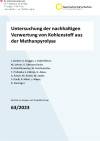Investigation of the sustainable utilisation of carbon from methane pyrolysis
Short Description
CO2-free or low CO2-intensity hydrogen production is going to play an integral role in a future energy system that is solely relying on renewable sources. Hydrogen enables coupling of the following sectors: electricity (production), gas and thermal heating, as well as energy storage from renewable overproduction. Furthermore, it contributes to climate-neutral mobility as well as industrial processes.
The state-of-the-art approach to hydrogen production, whilst emitting CO2, is mostly conducted by steam reformation of natural gas and is commonly used in chemical and petrochemical industries. To produce sufficient amounts of hydrogen for future applications exclusively from electrolysis of water, in Europe alone several thousand TWh of electricity from renewable sources would be necessary.
One of the possible alternative production-routes for renewable hydrogen is methane pyrolysis. The comparison with other production schemes shows that methane pyrolysis offers very high yields with the lowest energy consumption (less than one quarter of the energy consumption used in water electrolysis) possible. Concerning impacts on the environment resulting from energy intensive hydrogen production, methane pyrolysis is the superior process compared to all others.
Hydrogen produced by methane pyrolysis is considered CO2-free, because solid carbon is generated as a byproduct. For every one kilogram of hydrogen concurrently three kilograms of solid carbon are produced. For the purpose of a complete resource utilization a sustainable application of elementary carbon is of major significance. Experiments conducted at Montanuniversität Leoben confirm a correlation between the morphology of solid carbon and the pyrolysis-process or rather the catalyst material used. As a consequence, adjustments to the quality of produced solid carbon regarding
its modification and grain size to specific technical specifications2 are possible.
Because of the aforementioned fraction of three kilograms of solid carbon for every kilogram of hydrogen produced, a large-scale usage of carbon is of particular importance. On the one hand carbon can be used in construction as an additive to insulating materials as well as in building materials to enhance physical properties. Experiments concerning these applications conducted at the Graz University of Technology produced several promising findings. Furthermore, carbon can be used in agriculture to promote storage of water and nutrients in the soil, build up humus, and reduce the emission of greenhouse gases from the soil. Moreover, carbon can be used as an additive in composting and for the production of organic fertilizers. For agricultural use high purity carbon is necessary. Due to the potential positive ecological effects these applications are of particular interest. Intensive research at BOKU shows promising results for the application of solid carbon in agriculture.
Especially for large-scale utilizations of carbon, commercialization and processing can be assumed to be sufficiently convenient. Ideally the carbon produced from methane pyrolysis can be used directly without the need for laborious technological processing. Therefore, with regards to the development of pyrolysis technologies as well as the future implementation in large-scale facilities, a specific focus has to be put on the choice of process-routes and the assessment of important process parameters. Furthermore, a simultaneous ecological and economical assessment of possible applications for hydrogen and carbon for the purpose of sustainable technology development needs to be conducted. A complete utilization of all arising material- and energy-fluxes from the pyrolysis process is considered mandatory. An economic assessment for the usage of carbon from methane pyrolysis has been carried out by the University of Graz to understand displacement effects, geopolitical dependencies and market situations.
Publications
Untersuchung der nachhaltigen Verwertung von Kohlenstoff aus der Methanpyrolyse

Eine der möglichen alternativen Produktionsrouten für erneuerbaren Wasserstoff ist die Methanpyrolyse. Gegenüber anderen, alternativen Erzeugungswegen weist die Methanpyrolyse bei einer sehr hohen Wasserstoffausbeute den geringsten Energieaufwand (weniger als ein Viertel der Wasserelektrolyse) auf.
Series
63/2023
J. Burkert, K. Brugger, L. Haberfellner, M. Lehner, R. Obenaus-Emler, R. Hood-Nowotny, M. Puschenreiter, T. Prohaska, S. Zabrian, N. Alaux, A. Passer, M. Ruschi, M. Saade, S. Duelli, R. Maier, J. Mayer, K. Steininger
Publisher: BMK
Publication Downloads
Project Partners
Jonathan Burkert, Katrin Brugger, Laura Haberfellner
CCCA – Climate Change Centre Austria
Markus Lehner, Robert Obenaus-Emler
MUL – Montanuniversität Leoben
Rebecca Hood-Nowotny, Sanda Zabrian
BOKU – Universität für Bodenkultur Wien
Markus Puschenreiter
Natur-Umwelt-Nachhaltigkeit
Thomas Prohaska
MUL – Montanuniversität Leoben
Nicolas Alaux, Alexander Passer, Marcella Ruschi Mendes Saade
TU Graz
Samuel Duelli, Raphaela Maier, Jakob Mayer, Karl Steininger
Universität Graz
